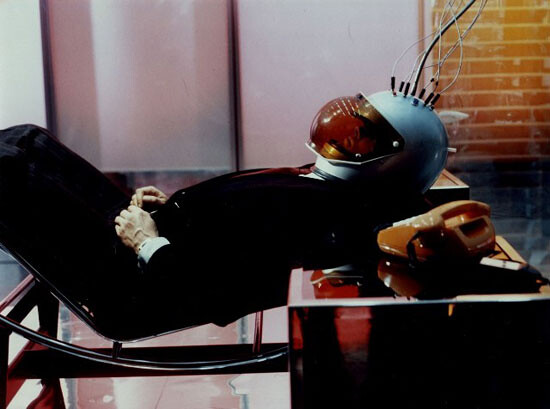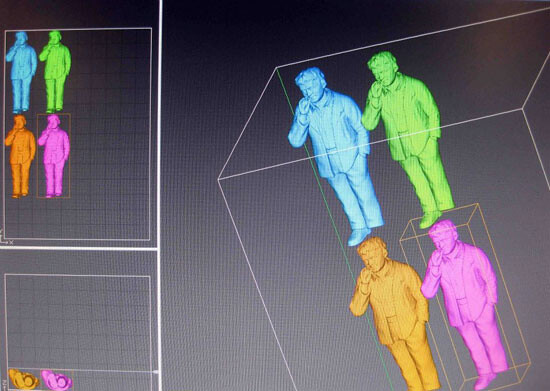Gean Moreno: Survivors of the strange hallucination that was called the End of History, we seem to be speaking again, and brazenly, of the Outside—an outside to the existing socioeconomic arrangement, an outside to existing forms of everyday life, an outside to the authority of institutionalized discourse. It is in relation to the reassertion of this figure or trope of the Outside that I read your contribution to Excommunication: Three Inquiries in Media and Mediation, and in particular your introduction of the concept of xenocommunication, a kind of laying down of lines of exchange with the alien. What is as interesting as the notion of xenocommunication itself is that its possibility generates an administrative race for portal control. Someone has to patrol the points of contact. And the winners of the race have generally been gruesome power-forms, like the Church or the Party dictatorship. In what you write, I sense the latent proposal that at this moment there is no credible border patrol that regulates contact with the Outside. And this makes our moment one of possibility, of being done with these portals altogether.
McKenzie Wark: It may be because, while a third generation atheist, I come from a Protestant culture. We don’t take kindly to authorities who claim to have been granted exclusive rights by the other to be its representatives, be they God-botherers or Lacanians.
My part of the Excommunication book, co-written with Alex Galloway and Eugene Thacker, is indeed about xenocommunication, in the double sense of communication with what is strange and also a sort of hospitality toward what is alien. I wanted to propose, speculatively, that communication seems to flourish under a sort of enabling condition inherent to xenocommunication—communication with what, in a sense, isn’t there or can’t be there. But rather than St. Paul, I wanted to follow the path of the heretics and dissenters who refused to abide by authorized channels of xenocommunication, let alone police them, as Paul did—comparable to NSA of xenocommunication. So I sketched a little counter-history to the Judeo-Christian controllers of the portals to xenocommunication. This counter-history included the heretical sects such as the Babelites, and modern descendants of the heretics such as Charles Fourier, Raoul Vaneigem, and François Laruelle.
Laruelle, incidentally, could be read in a strikingly Protestant fashion. There’s nothing to be done to earn Grace. Xenocommunication is all in one direction. The other may indeed communicate to us, after a fashion, but there’s no reciprocity, no exchange. Or you could read it via Epicurus and Lucretius: sure, the Gods exist, but they hardly notice we exist. This idea may be more liberating than the notion that God is dead, which only cleared the space for Man to take His place as the correlate of Nature. Perhaps we are better off constructing the space of thought around the notion that the One is unilateral, that there’s no exchange, and hence nobody can be the agent with exclusive rights.


GM: Is this one of the possibilities opened up by Laurelle’s conception of the unilateral One—that the Outside, what is other to us, is now on the Inside somehow, inside the social totality itself? There is nowhere else to go looking for it.
MW: Yes, whatever you want to call it, the outside, the alien, alterity—it was never far away. There is only what Tim Morton calls “the mesh.” There isn’t actually a big other. It’s very hard to grasp this, as it has to do with the way things aren’t neatly nested in a hierarchy of scales, from big to small, passing though a middle range of scales which the human can understand. One doesn’t really need a specialist to monitor the portal to the absolute on one’s behalf, as if it were on a larger scale that only someone of higher rank could apprehend.
The odd thing is that we believe xenocommunication must have a limit condition in order to set a bound, within which communication about the regular scales in the regular way can proceed. But there’s nobody who can actually ground a claim to xenocommunication as a special right. Philosophy has interestingly gone in some different directions to attempt this. One is reactionary: a return to religious language. The other is more ingenious, and rests, for example, on a claim that mathematics is ontology. This is a revival not of religion, but of Pythagoras.
A theological void or a mathematical ontology might give you an interesting way to talk about the absolute, and it might be fun and profound and perhaps even compelling. But it isn’t necessary. It has no reciprocal, iterated, adjustable means of encountering its object of thought. It’s the absolute as fetish. The natural sciences, on the other hand, sometimes really do provide knowledge of things that are inhuman, if not entirely nonhuman. For a long time, science has proceeded via an apparatus, a series of techniques. Science is a kind of media, a communication with inhuman things. Science allows us to read off, as it were, signs of a world utterly indifferent to us, but in a way that does have a limited kind of reciprocity and iteration. You can test the results, adjust them, even improve them. Theology and philosophy’s pretensions to somehow exceed that, or regulate it, or legislate for it, are clearly ridiculous. But bizarrely, such claims have returned.
I think a more modest approach is called for, a kind of low theory, which is no more than a creole language for negotiating different ways of living and producing knowledge. But I don’t think we can speak anymore of the virtues of the tactical, the marginal, the local, the different, and so on. Tiny things won’t save us from big things. It’s more a question of realizing that this hierarchy of scales simply doesn’t exist. Thought has gone from thinking difference to thinking universality, as if these corresponded to different scales, to little and big. But they don’t. Carbon atoms and the biosphere directly communicate. We’re living in an era of thinking about how tiny things are simultaneously big things, particularly in such an intensively networked world. We have tended to think local/global and different/same and little/big as concepts collapsed onto one another. Instead, it’s time to think the scale-free mesh.
GM: How does one work within this scale-free mesh? Where does one invest energy and resources, if the goal is to stop reproducing the world as it is, if there is no longer a correlation between the artifact (cultural, religious, and so forth) and some version of the absolute, if Utopia can’t be captured in any productive way in the object that holds its place, as some kind of anticipation and promise of it, or even a prod to actualize it? Although in Excommunication you employ infrastructure as a metaphor for the Real or One, I intuitively want to say that infrastructures—concrete infrastructures, the networks through which resources are distributed and through which “small” and “large” communicate directly (and undo this hierarchy of scales)—are good sites for intervention and inflection. This intuition figures into how I understand some of the complaints you have voiced regarding the ineffectiveness of contemporary art.
MW: It’s interesting how otherwise very different critical theories of the aesthetic all ended up in the same place. After Adorno, you could think of the work of art as genuine non-equivalence, as that which refuses the extorted reconciliation of exchange value. After Althusser, you could think about art as part of a specialized superstructural domain, with relative autonomy from infrastructural struggles. After Rancière, you could assimilate the aesthetic to the political, such that any aesthetic act, if it redistributes the sensible, somehow magically counts as politics at the same time. Or you could go the postcolonial route and see representations of the other as having a special power function in need of deconstruction, in the broadest sense of the word.


All of these, incidentally, tended to be based on some sort of exchange or structural relation between infrastructure and superstructure. It was a reproduction, in a social and quasi-Marxist language of the old subject/object correlation. But what if (1) we never really know in advance what is infrastructure and what is superstructure? The cutting up of the social whole in advance, as a conceptual a priori in Althusser, is just complete nonsense. And (2) what if infrastructure and superstructure are in no way equivalent or comparable instances of the social formation? What matters about infrastructure is that it is base, in every sense—basic, but also messy, disgusting, primal, an encounter via an apparatus with something very inhuman.
This is why I am interested in those critical theories and those avant-gardes that really delved into this vulgar question of the base in different ways: from Alexander Bogdanov, Boris Arvatov, Andrei Platonov, and the various forms of Proletkult in the Soviet twenties, to George Bataille’s general economy and Situationist practices of potlatch and détournement. These things were modest in effect, but were really about prototypes of new kinds of aesthetic economy and technology. Incidentally, this is also what concerned Walter Benjamin, although it is quickly read out of him—his interest in the apparatus of cinema as a kind of inhuman perception, and mechanical reproduction as a blow to a certain form of property relation in aesthetics. Or in short: art has to be basic and vulgar or not at all.
GM: Being vulgar and basic, assuming the condition of a prototype of a relation (rather than an object)—considering the examples you offer, is the most productive space for art found in the social field? There seems to be here an implicit critique of both the art institution and the current obsession in art practice and theory with self-referentiality and media specificity.
MW: If one has any knowledge at all of the actual world, how could one not respond to the current dominants of the art world with anything but sheer boredom? Not that there aren’t interesting counter-currents and pockets, but the dominant capital-A Art World is just decoration. IKEA for billionaires. It’s just of no interest to anyone who isn’t being paid to pay attention to it. That’s why I find design and architecture more interesting domains, where people are not just trying to prototype social relations but also asocial relations, i.e., questions of infrastructure, the inhuman, and so on. Those are fields that don’t just play field-specific, self-referential games.
On the other hand, is there not still some terrific potential in the resources of art? What if we turned the whole thing inside out? What if we grabbed ahold of both the Art World and what Greg Sholette calls the “dark matter” of art, all those art teachers and students and Sunday painters, and treated all of that as potential resources for experiments in another way of life? It would be a question of an avant-garde of a more old fashioned kind, one not designed in advance to be fashion-leader in the Art World. One which really did try to abolish and supersede art as we know it. Wouldn’t that be fun?
Asger Jorn thought that the problem with the modern world was the split between work, which pours content into forms, and design, which creates the forms for content, and art, which had become a kind of content-less form. He wanted to heal the rift, and indeed to abolish the commodified relation in which forms just hold contents—like tins hold soup—so they can be exchanged and consumed. It would be a question of what Chiara Bottici calls the “imaginal,” which is a bit like what Castoriadis called the “imaginary institution of society”: a collective, collaborative practice of creating new forms that are not purely formal, but are proposals for forms of life. The art that still does that is the art that still interests me.


GM: The other thing that we should delve into more is the relation between the natural sciences and the inhuman. This is particularly interesting in relation to what Benjamin Bratton calls the “post-Anthropocene,” the moment in which we, our biological formats, as well as certain technological and political horizons, will be phase-shifted, recast as the beta version of new and—to us—alien formations.
MW: Natural science is alien knowledge. The way it breaks out of the correlation of knowing subject and knowable, phenomenal object is via a third thing: the apparatus. The apparatus is an assemblage of tech and labor which registers and measures perceptions of what is inhuman, and mediates these perceptions back to the human, secondarily, as an aftereffect. This is why, incidentally, there can be no philosophy of science anymore, but only a media theory.
Take climate science—a key science of our time. It rests on an apparatus of very powerful computers and communication vectors, which overcome the “friction,” as Paul Edwards calls it, between data and communication. It brings together global data according to global standards, mathematical models of the physics of climate drawn from fluid dynamics, and massive computational power. The model and data coproduce each other in a way, as the data sets are all partial, and many data points have to be interpolated to make the models work. And then all of that has to be mediated back to human awareness via tables, graphs, computer simulations, and so forth.
Our ability to even know the basic physics and chemistry of the biosphere and predict the outcomes of adding massive amounts of carbon to it is very recent, maybe only thirty years old. But the apparatus in general is not new, and perhaps not even unique to our species. Our species has always perceived the world via an apparatus. We measured time using marks on a stick or a rock, perhaps right from the start. There was never a point where we didn’t have tools. We experience wood or stone or the earth through tools that cut and dig. We have always experienced the world via an inhuman apparatus of labor and tech. There was never a human without the inhuman.
Now it’s a question of whether the infrastructure of the human/inhuman apparatus, with its tentacles deep in base matter, can be a means to produce a qualitatively different version of itself. What I hear Ben Bratton asking is this: Can this infrastructure produce another one? Can we modify the means of production? Not so much by “revolution”—which is usually no more than a superstructural phenomenon—but by mutation. A mutation at one and the same time of tools, relations, economies, affects, and so forth. Our job is really to prototype elements of a new mode of production.


GM: In some way we are back to the secularized outside, the other that is already there waiting to be extracted, not through xenocommunication but through tinkering, through experiments that induce mutation. Science, at the moment, may be the place to look for alien knowledge, but it seems design—with its quasi-artistic freedom and penchant for speculative prototyping—may be where new apparatuses can be generated and through which infrastructures can be tested for porosity and pliability.
MW: Yes, I find design, or the borderlands between design, art, architecture, and technology, to be an interesting zone. It has to be said that this may not be a golden age for science and technology. We are constantly told that we are living in an era of “disruption” and “innovation,” which makes one think that in reality it’s quite the reverse. It’s an era of the relentless same of commodification. But there are lots of people across the whole spectrum, from the sciences to technology to design, who want more than that, and who are actively working outside that framework. One of the great challenges of the times is to reconnect the imaginal energies in the sciences to those in the humanities, and perhaps something like design is a good meeting point for working that out. As my New School colleague Anne Balsamo argues, there’s a technological imagination, a cultural construct, which sets certain limits on what kinds of projects tech people can initiate and organize. So in part, it’s a question of broadening the technological imagination.
I have made a few modest works which sit in that space. The networked-book version of Gamer Theory, for example, was a way of imagining what the collaborative labor of writing could be like. Or the #3Debord project, where we made 3D-printed Guy Debord action figures. It was a way of asking questions about the two key concepts of Debord’s work: spectacle and détournement. What does it mean to move beyond the world of images and toward the world of things in both spectacle and détournement? This was what flipped people out, I think—that you could make a free .stl file of Debord himself. Isn’t that a commodity? Maybe, but they were not for sale, and the file is free. Anyone can make one, or modify one. So what kind of object is that? These might be minor examples of what one might call conceptual design. Maybe it’s no big advance over the self-referential and medium-specific obsessions of the art world, but at least it’s about different fields of reference, and different media. And it’s an inquiry that could point outwards rather than inwards. What’s out there? What kinds of practice, nibbling around the edges of an apparatus, might take a little step into the great outdoors?
GM: Let’s talk about writing—not your writing habits as much as the rate at which you seem to put material out, your promiscuity with different platforms, and the way you often employ the same material in multiple contexts. Unlike some of the writers you have written about, who often favored self-marginalization, you seem interested in a kind of incessant dissemination and a non-academic form of public exchange. How do you see it?
MW: When Charlie Parker was asked his religion, he replied, “I am a devout musician.” While not claiming to put myself on the same level as Bird, it’s the same with me. I’m a devout writer. It’s just what I do, and pretty much daily. As a former journalist I know how to write quickly. I know that, as Walter Benjamin said, “the work is the death mask of its conception.” So at a certain point it’s just done and it’s time to move on.
One thing that comes with being a writer, one steeped in the moderns and the avant-gardes, is that I don’t just accept the conventions of either scholarship or journalism. I’m interested in taking the whole practice as an object of critique and experiment, including economies and technologies. And of course I have been on Facebook for twenty-five years, by which I mean that I came up through Bulletin Boards, Usenet groups, The Well, and in particular the listserv-based avant-garde of Nettime.org. So naturally I’m interested in how one works in and against the dominant textual culture industries of our time. The only way you get to write books—which is what I really love—is if you create the readership for them.
That would be my writerly response. But I am also a former militant, and so I have a certain training in modes of address. I’m more interested in confounding than persuading these days, so in that sense the avant-garde rather than the militant training I had won out in terms of practice. It’s best, I think, when there’s a certain element of play in writing as a practice.


GM: Although in recent years you have dedicated a great deal of time to the Situationists International, there is a new project afoot on post-revolutionary Russian culture. Would you say something about it?
MW: I think we need new ancestors. The old ones, in art and theory, have been exhausted and are exhausting us. One can’t just be done with the past, however. One always takes two steps back to take three steps forward. But I think it’s time to see the archive more as a Borges-like labyrinth rather than a lineage, particularly on the theory side. So I’m working on an alternate history of the intersection of critical theory and the avant-gardes in the twentieth century. The Beach Beneath the Street and Spectacle of Disintegration are putative volumes three and four of a series.
Molecular Red, which I am completing now, is volume one. It’s about Alexander Bogdanov, Lenin’s rival for the leadership of the Bolshevik Party and the founder of Proletkult. It’s also about Andrei Platonov, the finest product of the Proletkult avant-garde. It’s a way to thread through a certain moment of the October Revolution, a different moment than the Trotskyist one, which keeps asking over and over where it all went wrong. It’s also an alternative to what is usually taken to be the avant-garde of the Soviet twenties—the futurists, constructivists, formalists. In the latter story, Proletkult is usually conspicuously absent, because its practitioners wanted so much more than a new style—they wanted a whole new mode of production in culture and science.
In short, I’ve been spending some time showing the riches that have been left out. We don’t need to keep quoting Heidegger for fuck’s sake. Art does not have to be endless iterations of the Duchampian gesture. We don’t have to revive Lenin, as if no other radical thought ever existed. I’m rather drawn to heretics. If we must have ancestors, let’s not have the Name of the Father. Let’s have funny aunts and queer uncles. It’s much more fun, and maybe it’s even a way to unblock the stasis in contemporary art and theory. You have to admit that it’s been a bit boring.

